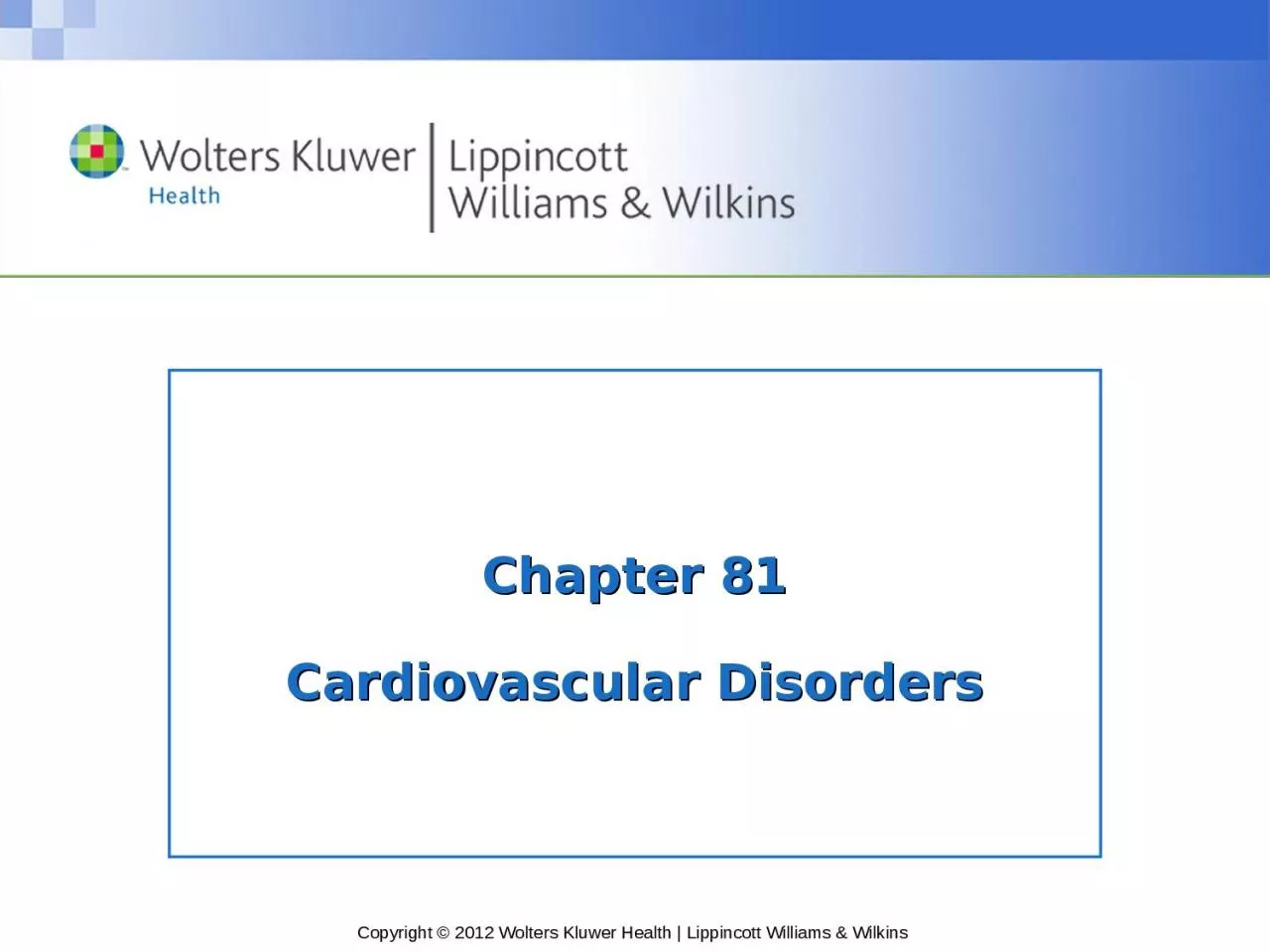

Cardiovascular Disorders Cardiovascular disorders may Interfere with the hearts ability to pump Disrupt blood flow within the coronary or cerebral vessels Disrupt blood flow to a localized area ID: 1035927
Download Presentation The PPT/PDF document "Chapter 81 Cardiovascular Disorders" is the property of its rightful owner. Permission is granted to download and print the materials on this web site for personal, non-commercial use only, and to display it on your personal computer provided you do not modify the materials and that you retain all copyright notices contained in the materials. By downloading content from our website, you accept the terms of this agreement.
1. Chapter 81Cardiovascular Disorders
2. Cardiovascular DisordersCardiovascular disorders mayInterfere with the heart’s ability to pumpDisrupt blood flow within the coronary or cerebral vesselsDisrupt blood flow to a localized areaCardiac nurses Coronary care unit (CCU) Coronary intensive care unit (CICU)
3. Laboratory TestsSerum enzymesCreatinine kinase, isoenzyme, lactic dehydrogenase, aspartate aminotransferase, troponin, and myoglobinBlood lipid (fat) studiesSerum electrolytesPotassium, sodium, and magnesium
4. LaboratoryCK-, CK-MBMyoglobinTroponin I-rise in 3-4 hours/normal 5-9 daysTroponin T- normal 10-14daysLook up what they are when they rise and fall
5. Angiocardiogram/ Arteriogram -Catheterization
6. EKG
7. X-ray EvaluationsAngiocardiogram (angiogram) ArteriogramTest using radiopaque dyeAsk clients if they are allergic to shellfish or iodine.This dye could cause a severe anaphylactic reaction.Study in which the femoral site is usedClient should lie flat for up to 8 hours to prevent swelling, bruising, and bleeding at the puncture site.
8. Other Diagnostic TestsElectrocardiogramStress testEchocardiogramNuclear scanElectrophysiology studyCardiac catheterizationImmediately report a client’s rapid or irregular pulse after cardiac catheterization.
9. Common Medical TreatmentsPharmacologic therapy: Thrombolytics or fibrinolytics Clients for thrombolytic therapy History of chest pain within the past 6 hoursIschemia of the heart that persists even after the administration of sublingual nitroglycerinNo recent history of surgery, organ biopsy, cardiopulmonary resuscitation, hemorrhagic CVA, bleeding abnormalities, intracranial neoplasm, recent head injury, pregnancy, or allergy to streptokinase
10. Common Surgical TreatmentsPercutaneous transluminal coronary angioplastyAtherectomyLaser angioplastyCardiac surgeryCoronary artery bypass graftingHeart valve repair and replacementHeart transplantation
11. Nursing Considerations Before SurgeryPreoperative teachingDischarge planning, plans for cardiac rehabilitation.Client’s nutrition and capacity for healing Supplemental oxygenation needs before and after surgeryVitamin and mineral therapyRoutine tests and procedures
12. Nursing Considerations After SurgeryMaintaining airway and ventilationProviding adequate tissue oxygenationMonitoring and maintaining cardiac functionMaintaining fluid and electrolyte balanceControlling chest drainage with suctionMonitoring body temperatureIdentifying signs and symptoms of complicationsRelieving pain
13. QuestionWhich of the following is an indication for heart valve surgery?a. Chest pain, dyspnea, syncope b. Headaches and migrainesc. Chest congestiond. Heartburn and intense discomforte. Rapid heart rate
14. Answera. Chest pain, dyspnea, syncope Other indications for heart valve surgery are:Angina, heart failureMitral or aortic valvular insufficiencyDamage to valvesPulmonary valve stenosisTricuspid regurgitation
15. Nursing ProcessData collectionPlanning and implementationTeaching about preventionEvaluation
16. Abnormal Conditions That May Cause Cardiovascular DiseaseArteriosclerosis: Hardening of the arteries Atherosclerosis: Fatty deterioration of the arterial smooth muscle wallsHypertensionLeading cause of MI, cardiac damage, kidney damage, congestive heart failure, and CVAHypotensionHeart rate problem, a heart muscle or pump problem, or a volume problem
17. Conditions Affecting the Heart’s RhythmCardiac dysrhythmiasSinus tachycardiaSinus bradycardiaPremature ventricular contraction (PVC)Atrioventricular heart block Electronic pacemakerFibrillationDefibrillationImplantable cardioverter–defibrillator
18. QuestionIs the following statement true or false?During electrical defibrillation, ensure that those present in the room do not touch the client or bed.
19. AnswerTrueDuring electrical defibrillation, everyone present must be careful not to touch the client or the bed; doing so will lead to shock and, possibly, injury.
20. Conditions Affecting the Heart’s Pumping FunctionCongestive heart failureHemodynamic monitoringMeasure intake and output (I&O) and weigh the client daily. CardiomyopathyDilated or congestive cardiomyopathyHypertropic cardiomyopathyRestrictive cardiomyopathy
21. Infectious and Inflammatory Heart DisordersChronic rheumatic heart diseaseBacterial endocarditisMake the person as comfortable as possible.Instruct client to conserve energy.Frequently note the pulse rate and quality.Observe closely for fluctuation in body temperature and for any symptoms of complications. Pericarditis
22. Coronary Artery DiseaseAngina pectorisTemporary loss of oxygen to the heart muscleIschemia—if loss of oxygen supply continuesMyocardial necrosis—death of heart tissueMyocardial infarctionAcute coronary syndrome (ACS) Acute myocardial infarction (AMI)
23. QuestionIs the following statement true or false?Thrombolytic therapy must be started as soon as possible after the client develops symptoms.
24. AnswerTrueThrombolytic therapy must be started as soon as possible after the client develops symptoms. The sooner the pharmacologic agent is administered, the less heart muscle damage results.
25. Inflammatory DisordersThrombophlebitisEmbolismPulmonary embolismCoronary embolusCerebral embolism
26. Peripheral Vascular DisordersSymptoms Intermittent claudicationTingling and numbnessColdness and difference in sizeLack of new tissue growthBuerger diseaseRaynaud phenomenonVaricose veinsTelangiectasia (spider veins)
27. QuestionIs the following statement true or false?For a client with peripheral vascular disorder, the bath water should be hot—as hot the client can take.
28. AnswerFalseIt is true that warm baths to help increase the circulation, but the bath water should not be hot, as heat helps dilate blood vessels. This client is very susceptible to burns. Use a bath thermometer; the maximum temperature is 100°F or 37.8°C.
29. AneurysmsAn aneurysm is an outpouching of a blood vessel.Forms of aneurysms Berry aneurysm in the circle of WillisFusiform-type aneurysm of the abdominal aortaDissecting aortic aneurysm
30. Types of Cerebrovascular AccidentTransient ischemic attack (TIA)Cerebral thrombosisCerebral embolismCerebral hemorrhage or aneurysm (hemorrhagic CVA)
31. Results of Cerebrovascular AccidentHemiplegiaFlaccid stage, spastic stage, recovery stageAphasia and dysphasiaBrain damageHemianopsia (hemianopia)PainAutonomic disturbancesPersonality changes
32. RehabilitationIf contractures are prevented, the client can learn to walk again much sooner. If the skin is kept intact, the client will not have to contend with ulcers and infections.If bowel and bladder training have begun, the client will be well on the way to independence.Teach adaptive ADL.Begin speech, physical, or occupational therapy as soon as possible.
33. End of Presentation